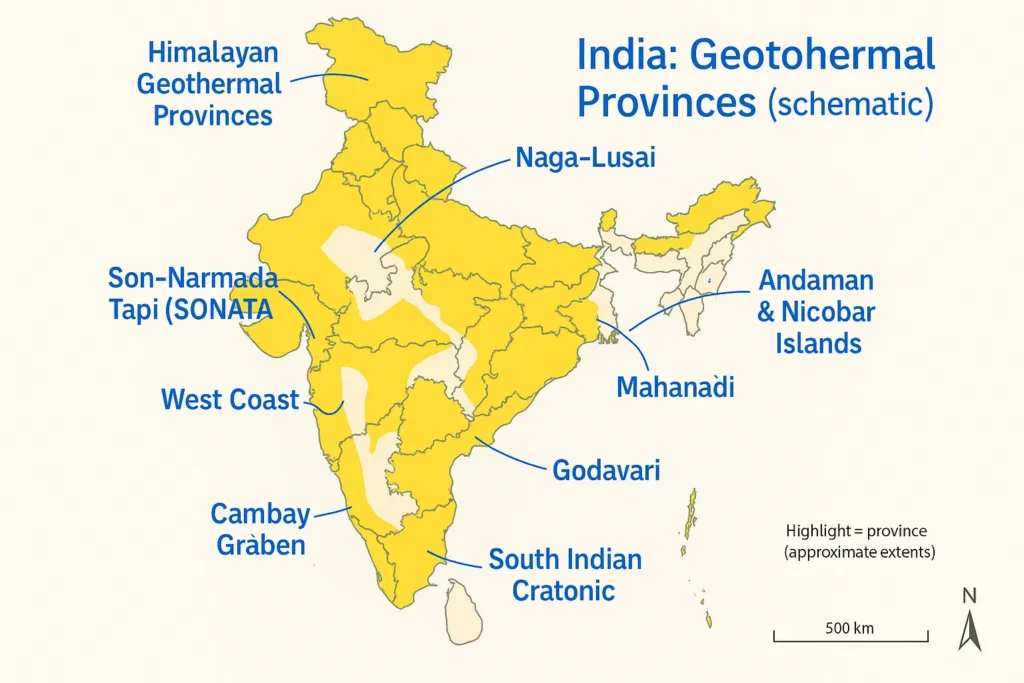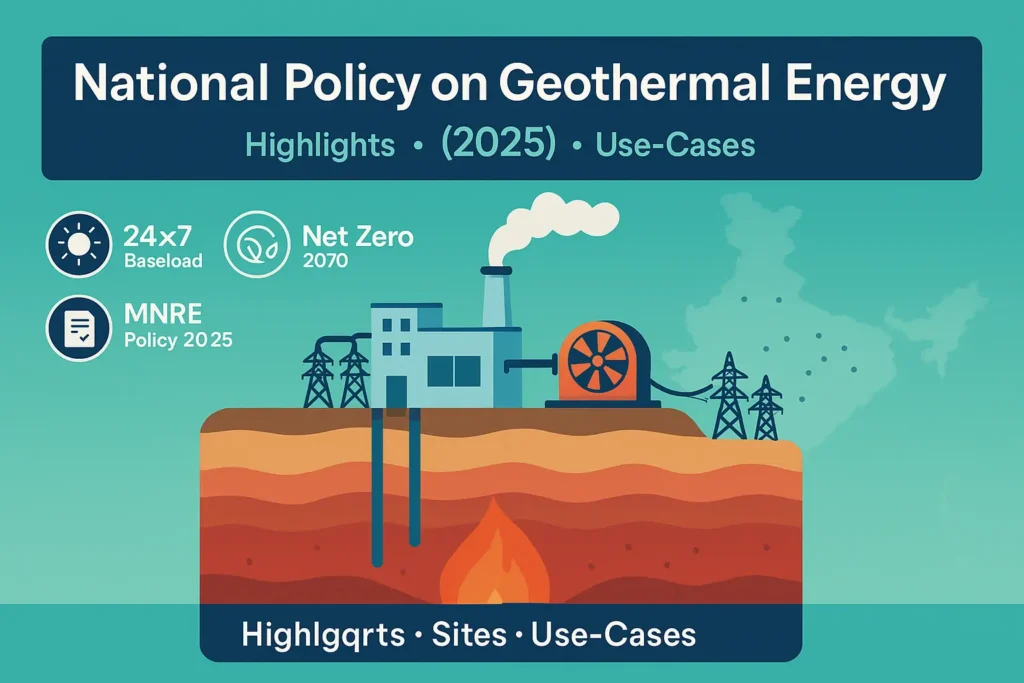National Policy on Geothermal Energy (2025)
Table of Contents
India has officially notified the National Policy on Geothermal Energy, signalling a serious push to tap Earth’s heat for 24/7 clean power, direct heating/cooling, agri-processing, and more. The policy aligns with the 2070 Net Zero goal and sets out clear roles, enablers, and a roadmap for states, developers, and research bodies.
National Policy on Geothermal Energy: key takeaways (at a glance)
- Notification & purpose: MNRE has issued the country’s first framework to explore, develop and deploy geothermal resources—covering power generation and direct-use applications. Regulatory stewardship rests with MNRE.
- Net Zero fit: The policy explicitly ties geothermal deployment to India’s 2070 Net Zero and energy-security objectives.
- Global context: Global geothermal capacity was ~15.4 GW at end-2024; the U.S. leads, followed by Indonesia and Philippines.
- Data & governance: MNRE will enable a national geothermal data repository (with DGH/NDR access) and streamline clearances via single-window state nodal agencies.
- Finance enablers under consideration: risk-mitigation support, VGF, concessional loans, sovereign green bonds, tax/GST/import-duty relief, RPO eligibility, “must-run” status.
- FDI: Up to 100% FDI (automatic route) continues to apply to renewables, which can help crowd in capital.
What is in the National Policy on Geothermal Energy (2025)?
The policy defines geothermal as heat within the Earth’s crust and covers high-enthalpy (power-grade) as well as low/medium-enthalpy resources suitable for direct uses (district heating, greenhouses, aquaculture, industrial heat) and ground-source heat pumps (GSHPs). It clarifies scope (resource assessment, drilling, power systems like ORC/flash/binary, GSHPs, and emerging tech—EGS/AGS, hybrid geo-solar, closed-loop, geothermal storage).
Why this National Policy on Geothermal Energy matters now
Geothermal delivers round-the-clock, firm clean power, improves grid stability, has low life-cycle GHG emissions, and can be especially valuable in remote/interior regions—precisely where diesel and high-cost fuels dominate. For India’s oil & gas ecosystem, the policy explicitly encourages repurposing idle wells—turning legacy infrastructure into low-carbon assets.
Where the heat is: mapping potential under the National Policy on Geothermal Energy
Resource base: GSI has mapped ~381 hot springs nationwide across 10 geothermal provinces
- Himalayan Geothermal Province;
- Naga-Lusai;
- Andaman Nicobar Islands
- Son-Narmada Tapi (SONATA);
- West Coast
- Cambay Graben
- Aravalli
- Mahanadi
- Godavari
- South Indian Cratonic

Currently, GSI has identified following geothermal energy sites:
- Puga, Chumathang, Gaik, Demchok, Nubra, (Panamik), Galhar, in UT, Ladakh
- Sidhu, Jammu and Kashmir
- Manikaran, Kasol, Tattapani, Tapri in Himachal Pradesh
- Tapoban, Gari, Joshimath, Juma, Jamunotri, Ganganani, Beda, Joti, Nyu, Dar, Bheti in
- Uttarakhand
- Tsachu (Tawang), Takshing, Arunachal Pradesh
- Polok, Yumesamdong, Sikkim
- Sohna, Haryana
- Bhimband (Munger), Bihar
- Surajkund, Tantloi, in Jharkhand
- Bakreshwar, West Bengal
- Tattapani in Chhattisgarh
- Anhoni, Madhya Pradesh
- Dholera, Tuwa, Tulsishyam, Gujarat
- Deulajhari (Athmallik), Attri, Odisha
- Unhavare (Khed), Sativali, Tural, Maharashtra
- Manuguru, Telangana
Tech & applications emphasized by the National Policy on Geothermal Energy
- Power: Modular ORC/flash/binary plants; EGS/AGS to tap hot dry rocks where natural fluids are limited.
- Direct use: District heating/cooling, agri/aquaculture, industrial process heat, food drying, geo-tourism, desalination; strong emphasis on GSHPs for buildings.
- Hybridisation & innovation: Hybrid geo-solar plants, closed-loop systems, heat storage; retrofitting abandoned oil & gas wells to lower costs/risks and speed scale-up.
Guidelines to States
- Data & coordination: MNRE-led repository integrating GSI, DGH/NDR, CGWB, CSIR-NGRI; developers must contribute back data—reducing exploration risk for the ecosystem.
- Permitting: Single-window state nodal agencies for land/water/forest/environment and grid access; streamlined, concurrent clearances via portal, with defined exploration/development tenures.
- Capital: 100% FDI (automatic route) in renewables remains available—pair this with JV models and state incentives to de-risk early projects.
FAQs on National Policy on Geothermal Energy
Is geothermal viable in non-volcanic India?
Yes—low/medium enthalpy dominates and is ideal for direct-use heat and GSHPs; power is feasible where resources are hotter and drilling economics work (including via EGS/AGS).
How big is geothermal globally right now?
About 15.4 GW of installed capacity as of end-2024, with the U.S. leading.
Which Indian state drilled its first geothermal energy well in 2025?
It is drilled by the Centre for Earth Sciences and Himalayan Studies (CESHS) at Dirang in Arunachal Pradesh.
In which country is the largest geothermal power plant?
Global geothermal capacity was ~15.4 GW at end-2024; the U.S. leads, followed by Indonesia and Philippines.
What is the rank of India in geothermal energy?
There is no official source to rank India in geothermal energy. But it is roughly around 15th place.
Which state in India produces the most geothermal energy?
Since geothermal energy is under initial stage, the MNRE have been identified Ladakh and Himachal Pradesh has high potential of geothermal energy reserves. The Government had planned to establish first 1 MW geothermal plant in Ladakh and a pilot plant established in Telangana.
Sources: PIB, MINISTRY OF NEW AND RENEWABLE ENERGY
